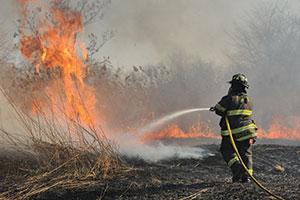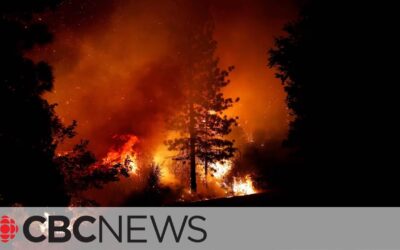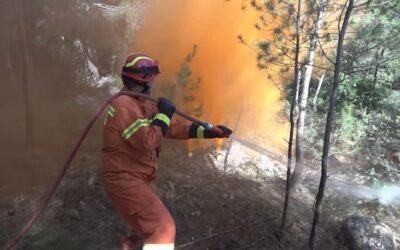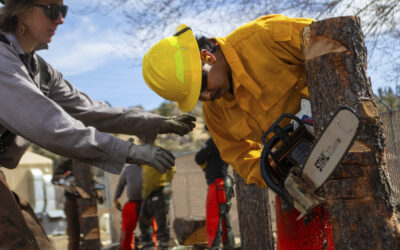Todd McNeal looks at developing cognitive resiliency at the engine company level.
By Todd McNeal
Published Wednesday, June 1, 2016 | From the June 2016 Issue of FireRescue
There is no question that the complexity of the wildland fire environment has increased over the past decade. This fact has been evidenced in the explosive fire growth and devastating losses during recent wildland urban interface (WUI) incidents through the West. All responding fire suppression personnel need to realize that they are stepping off the apparatus into the most volatile and dangerous wildland fire environment in the recorded history of our country. Fire growth is explosive, the destruction unparalleled, and the loss of life staggering. The recent years of drought in the West have only compounded the risks and potential for extreme fire behavior in the upcoming 2016 fire season.

The recent years of drought in the West have only compounded the risks and potential for extreme fire behavior in the upcoming 2016 fire season. (Photo by Steve White.)
All of these facts combine to significantly increase stress at the engine company level when responding and operating in this fire environment. The pressure and performance expectations placed not only on the company officer but on the entire company when tasked to defend these numerous values at risk are real. Stress and the resultant impacts on any human’s ability to cognitively perform under it detract from performance levels in this complex incident environment. There is no combating the involuntary human reaction to stress in relation to cognitive functions. Simply put: When exposed to stress, the ability of the human mind to successfully process input is reduced. There is no way to avoid it; it is automatic, and this fact has been scientifically proven time and time again by the military and the fire service. Stress reaction and the undermining of our prompt recognition of changing conditions and rapid response to that change are our enemy on the fireground. There are several ways to combat this stress reaction experienced by every human. I am suggesting one approach of building cognitive resiliency at the engine company level.
Collective Processing
What is cognitive resiliency? Simply put, cognitive resiliency at the company level is recognizing that the collective can process information better than a sole individual. A well prepared, trained, and informed engine company can operate at safer and greater effectiveness when all members understand their critical role in maintaining situational awareness and collective cognitive performance. Company officers must encourage and support all members to be actively responsible for processing critical crew safety input. At every level, the fire service has to embrace the concept that the whole company is far better at catching the significant safety risks than a single individual. All members need to be tasked and empowered with the assignment of tracking the changing conditions in the wildland fire environment.
This process starts with the company officer recognizing the importance and necessity of the collective and communicating this message to the crew on a consistent basis. Company officers need to be effective leaders and communicators who demonstrate by their voice and actions the need for the engine company to operate as one physical and cognitive entity. Irrefutably, the crew is stronger and safer when all are involved in risk management.
Within the task-saturated and time-compressed environment we are operating in during wildland incidents, all members must be fully engaged in accessing the constantly changing risks the company is exposed to. Several tested and proven methods can assist the company officer in this critical task of articulating the importance of cognitive resiliency within the engine company.
Resiliency Development
An excellent starting point to begin this development of resiliency is to make it one of the top priorities of the officer to train hard, frequently, and within the jurisdiction and environment to which your engine responds. Preplan those areas in your first due that have the potential for a rapidly expanding wildland incident. Make it a point to know to the greatest degree possible all potential interactions of fuels, weather, and topography in your area. If you don’t have that potential in your immediate response area, then use areas that your agency will most likely go based on historic responses and proximity. It cannot be overstated that repetitive scenarios under realistic conditions and in topography that is familiar will add to an individual’s knowledge base.
Thorough understanding of the highest-risk wildland areas will directly reduce the stress levels when the event does eventually occur through active training recall. This concept is commonly known as “recognition primed decision making†and is another automatic response of the human brain when faced with a new situation. If you put more information into the library while training, you will have an easier time recalling an appropriate response, and that equates to a reduced stress reaction in the individual.
Tactical Decision Points
Another method to reduce the stress response is to actively engage in the establishment of predetermined tactical decision points (TDPs) acquired though local knowledge or conclusive and rapid research of unfamiliar areas. I advocate that TDPs are simple safety elements and are extremely beneficial because they are easy to understand, recall, and implement in stressful, high-risk environments. A TDP is established prior to tactical engagement and, once reached, forces or “triggers†a firefighter to reevaluate his situational awareness, tactical progress and effectiveness, and ultimately his safety. These trigger points are simple, must be set, must be recognized and evaluated, and when reached CANNOT BE IGNORED!
If these simple but effective tools for operational safety are not in our tactical engagement evaluation process, our ability to manage risk is degraded and our stress reaction elevated. There are several types of TDPs, and they can be used in a variety of emergency situations, not just in the wildland arena. TDPs are always objective and are established in three basic categories:
- Fire environment.
- Operational environment.
- Time tag.
If the company officer clearly establishes these TDPs at every incident and communicates them to the crew along with the response desired once the TDP is reached, the delay and confusion are significantly reduced. There is a calming effect that occurs in firefighters’ minds when they are exposed to an unfamiliar event or one of high risk and complexity but know how to respond.
Reducing Surprise
The job of the company officer is to instill this concept in each firefighter and then reinforce its potency through demonstration in training and emergency response. Being prepared and familiar with the potential variables at any given incident help keep the surprise component to a minimum. If the company officer leads the engine company in completing the preparation and homework for wildland response, then the collective knowledge is higher, execution of critical tasks quicker, and safety of the response enhanced.
There is no doubt that a lot of important work has to be put in to be able to back up the commonly used statement of “Expect the unexpected,†and that is the direct responsibility of the company officer. Both current and future company officers must investigate, develop, and refine techniques to improve and retain cognitive resiliency in their engine company. The exact approach will vary by location and agency, but the model and the goal of attainment should be universally applied.




